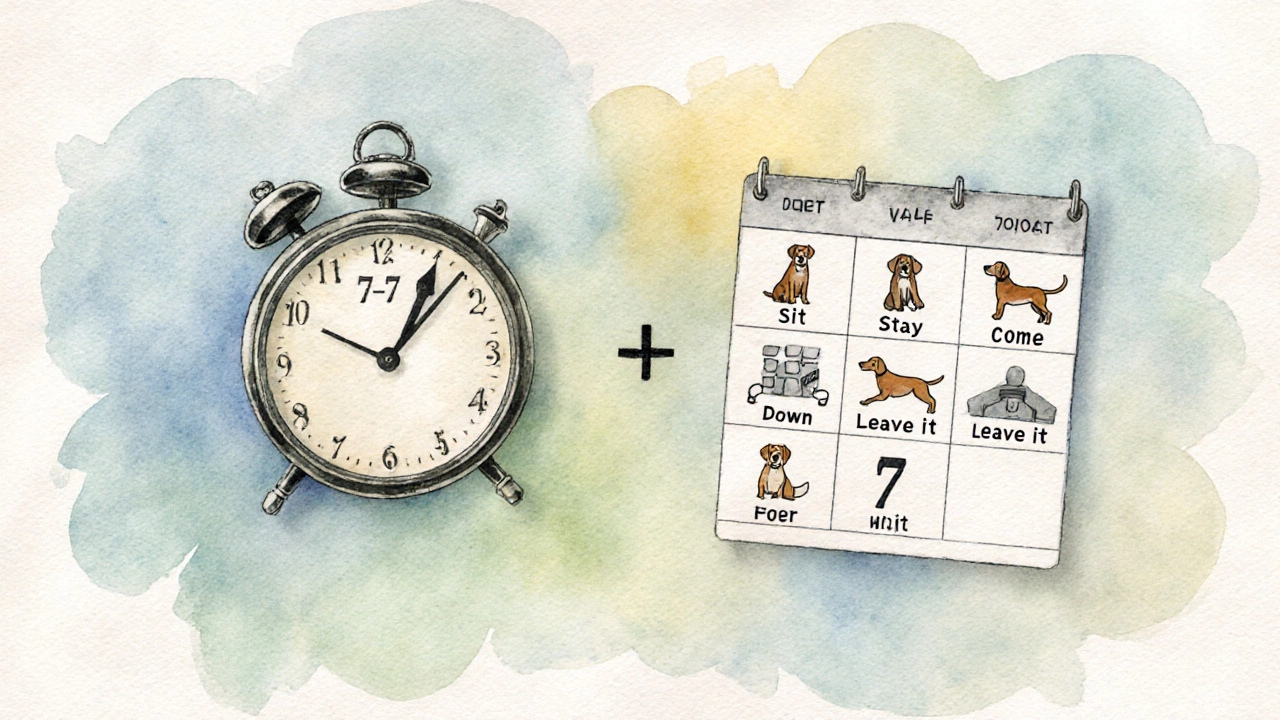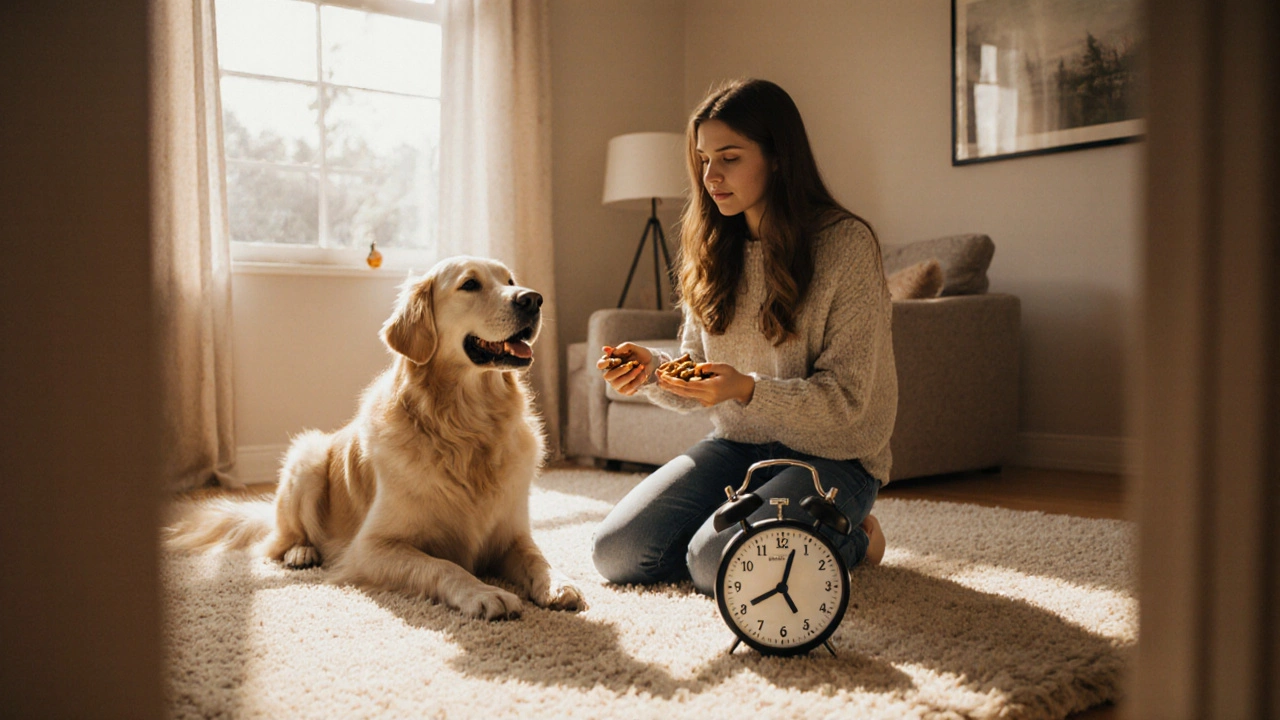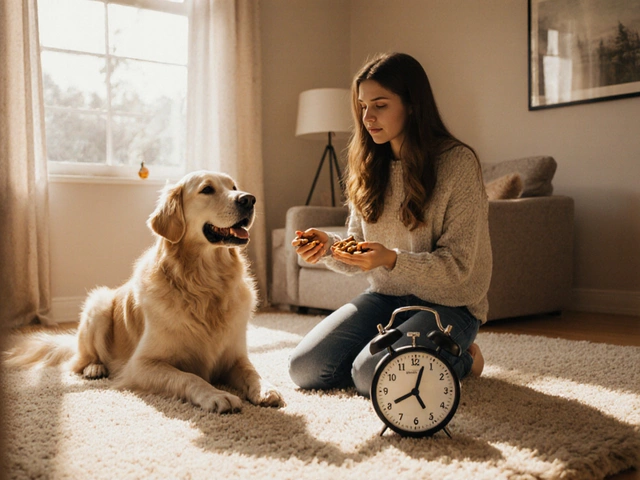Ever wonder why some owners swear by the 7-7-7 rule is a simple framework that recommends seven minutes of training, seven commands, and seven days of consistency each week while others ignore it? The short answer: it gives structure without overwhelming a dog’s short attention span. In this guide we’ll break down each part, show how it fits into modern dog training a collection of techniques that teach dogs desired behaviors using reward‑based methods, and give you a cheat‑sheet you can start using tomorrow.
Why a Rule Matters in Training
Dogs live in the moment. A 20‑minute lecture on “stay” will likely end in a distracted tail‑wag and a confused pup. The 7‑7‑7 rule respects that reality by keeping sessions short, focused, and frequent. Short bursts of learning boost retention-just like humans, dogs learn best when information is repeated in bite‑size pieces.
Breaking Down the Numbers
Let’s look at each “7” and why it’s chosen:
- 7 minutes - Most dogs can stay engaged for about 5‑10 minutes before their focus drifts. Seven minutes hits the sweet spot: long enough to practice a skill but short enough to avoid frustration.
- 7 commands - A typical beginner’s repertoire includes sit, stay, come, down, leave it, heel, and wait. Mastering these seven gives a solid foundation for more advanced tricks later.
- 7 days - Consistency is king. Practicing every day for a week reinforces neural pathways, turning a learned response into a habit.
Some trainers tweak the rule-adding a “7 repetitions per command” step-but the core idea stays the same: keep it manageable.
How to Set Up a 7‑Minute Session
Here’s a step‑by‑step routine you can follow:
- Positive reinforcement a training method that rewards desired behavior with treats, praise, or play - Gather high‑value treats your dog loves.
- Choose a quiet, distraction‑free area. A living‑room carpet works well for the first few weeks.
- Pick one of the seven core commands. Start with “sit” if you’re a total beginner.
- Use a clicker a small handheld device that makes a distinct sound to mark the exact moment a dog performs the correct behavior if you prefer clicker training, or simply give a verbal marker like “yes!”.
- Ask for the command, wait for the correct response, then immediately reward. Keep the exchange under ten seconds.
- Repeat the command 7‑10 times in that session. If your dog loses focus, pause, give some affection, and resume.
- End on a positive note with a quick game of fetch or a brief belly rub. This leaves your dog eager for the next session.
Repeat the same structure for each of the seven commands throughout the week. By the end of seven days, most dogs will reliably perform each cue on cue.
Integrating the Rule with Other Training Tools
While the 7‑7‑7 rule is a solid backbone, you’ll often pair it with other proven techniques:
- Reward schedule the pattern of giving treats, ranging from every correct response to intermittent reinforcement - Start with a continuous schedule, then shift to a variable schedule to keep the behavior robust.
- Puppy socialization exposing a young dog to new people, places, sounds, and other animals in a controlled way - Intermix short social walks after a training session to build confidence.
- Obedience commands basic cues that form the foundation of good manners and safety - Use the same seven commands as your core set, reinforcing them in real‑world settings like a park or vet visit.
- Behavior modification a systematic approach to reducing unwanted behaviors by replacing them with alternatives - If your dog jumps, teach “off” during a 7‑minute session and reward the calm alternative.
These tools aren’t separate; they weave into the 7‑minute blocks, making each session richer without adding extra time.

Common Pitfalls and How to Avoid Them
Even with a clear rule, mistakes happen. Spot the warning signs early:
- Skipping days. Missing a day breaks the habit loop. If you’re busy, do a micro‑session: a single command for one minute.
- Over‑rewarding. Giving treats every single time works at first but can lead to a treat‑dependent dog. Transition to a variable reward schedule after week two.
- Changing commands mid‑week. Stay consistent with wording. “Sit” should always mean the same hand signal and verbal cue.
- Training in noisy environments too early. Start in a calm space, then slowly introduce distractions as the dog masters each cue.
Addressing these issues keeps the 7‑7‑7 rule effective and enjoyable for both you and your dog.
Tracking Progress: A Simple Log
Write down what you practice each day. A quick table helps you see patterns and know when to move on to the next command.
| Day | Command | Reps | Notes (distractions, successes) |
|---|---|---|---|
| Monday | Sit | 8 | Focused, 100% success |
| Tuesday | Stay | 7 | Moved around, slight wobble |
| Wednesday | Come | 9 | Great recall from short distance |
Review the log at the end of the week. If a command shows consistent 90%+ success, you can start adding variations or increase the “7 repetitions” component.
Adapting the Rule for Different Dogs
Not every dog fits the exact numbers. Here’s how to tweak it:
- Senior dogs - Reduce minutes to 5, keep the seven commands but space them out over 10‑day cycles.
- Working breeds - Add a fourth “7” - 7 different environments (home, park, street, etc.) to build generalization.
- Rescue dogs with anxiety - Pair each 7‑minute session with a calming routine (e.g., a short massage) and use a very low‑value treat to avoid overstimulation.
Flexibility ensures the rule remains a tool, not a rigid prescription.

Real‑World Success Stories
Sarah from Bristol used the 7‑7‑7 rule with her 8‑month‑old Labrador, Max. Within three weeks, Max reliably sat and stayed on command even at the busy local market. The key, Sarah says, was “sticking to the seven‑day rhythm and never missing a session.”
Another example: Liam in Manchester applied the rule to his 5‑year‑old Border Collie, Bella, who had a habit of jumping on guests. By focusing seven minutes each night on the “off” command and rewarding only when Bella waited calmly, the jumping dropped from ten times a day to zero within ten days.
These anecdotes show the rule works across ages, breeds, and living situations-provided you keep the core principles intact.
Quick Checklist Before You Start
- Gather high‑value treats and a clicker (optional).
- Pick a quiet spot free of distractions.
- Write down the seven core commands you’ll teach.
- Commit to seven minutes daily for seven consecutive days.
- Track progress in a simple log.
Once you tick those boxes, you’re ready to roll.
Frequently Asked Questions
What age is best to start the 7‑7‑7 rule?
Puppies as young as 8 weeks can begin, provided the sessions stay under ten minutes and use gentle rewards. The key is to keep it fun.
Can I use the rule for advanced tricks?
Absolutely. Treat the seven commands as a foundation, then layer more complex cues within the same 7‑minute window. For example, after “stay,” add a “roll over” sequence.
What if my dog refuses to work for treats?
Switch to play‑based rewards (a quick tug or ball toss) or verbal praise. Some dogs are more motivated by interaction than food.
Do I need a clicker for the 7‑7‑7 rule?
A clicker is optional. It provides a consistent sound marker, but a simple “yes!” works just as well if you’re consistent.
How do I keep my schedule when I’m busy?
Break the 7 minutes into two 3‑minute bursts-morning and evening. Even a 2‑minute micro‑session counts toward the seven‑day streak.







